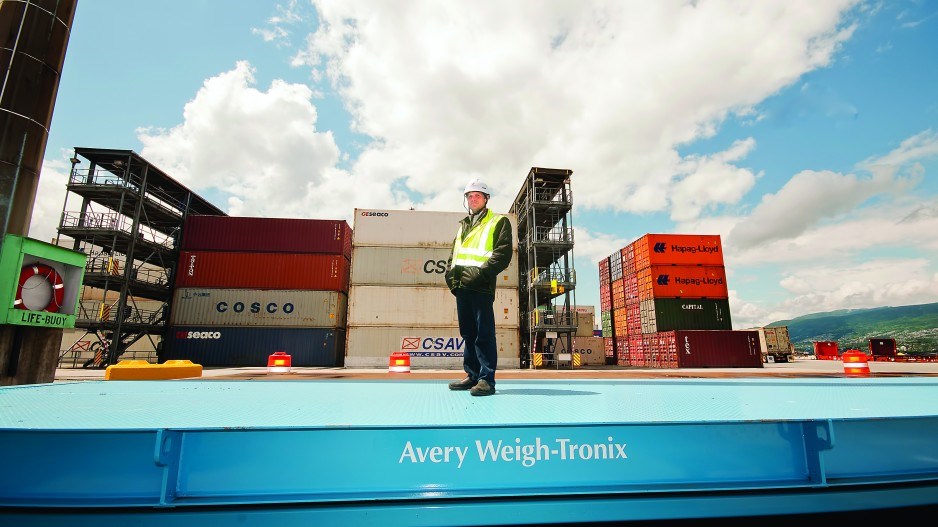For shippers the new weighting game is about to begin, but its rules remain a mystery to many.
That bodes ill for local manufacturers, importers, exporters and retailers who depend on a free flow of goods through Vancouver and other North American ports.
New international regulations governing container loading on deepwater freighters are scheduled to come into effect on July 1. But according to a recent American Shipper survey, stakeholders at key points in the logistics chain remain unclear about the implementation, execution and policing of the rules.
The shipping industry publication’s survey included hundreds of shippers, carriers, consultants, freight forwarders, port authorities and logistics companies.
It found “ongoing confusion” in the shipping and logistics ranks. A common thread running through debate over the new rules, it said, is that “shippers are not sure what will happen to their cargo on July 1.”
A May survey from Drewry reported similar results. Forty-five per cent of shipper respondents to the U.K.-based shipping consultancy’s poll said their service providers had not given them enough information about the new rules; 55% said they expect implementation of those rules to delay container shipments.
The new International Maritime Organization (IMO) SOLAS (Safety of Life at Sea) Convention amendments will require packed shipping containers to have a verified gross mass (VGM) before they can be loaded on a ship for export. Accurate container weights are critical to determining how a ship’s cargo is stowed. Mistakes or falsely declared container weights can upset cargo balance and reduce a ship’s seaworthiness.
But thus far there is a wide range of implementation and enforcement proposals among the 170 countries signed on to the IMO. And, as Jim Blaeser, vice-president of AlixPartners’ marine practice, pointed out, only around 10 have issued any guidance on those proposed procedures.
In Canada, shippers will have to comply with Transport Canada and Measurement Canada requirements. Penalties for violating the new weight verification rules will range from $600 to $12,000 per infraction.
In the U.S., the coast guard has deemed the SOLAS regulations to be a commercial matter between carriers and shippers. Enforcement will therefore be in the hands of shipping lines.
How the rules will be enforced in less regulated regions around the world is anyone’s guess.
Blaeser added that the SOLAS regulations require shippers to verify a container’s weight at a point that’s relatively close to its departure. “And the shipper is probably not anywhere near where the departure is. [So] there is a [level of] communication and infrastructure that needs to come with this that has not really been thought through or understood yet.”
Responsibility for providing accurate VGM is also a major issue.
“Signing your name to it … is kind of like putting your hand on the Bible and saying this is the right weight.”
Blaeser added that the global container shipping sector, struggling with overcapacity, stalled economies and record-low container shipping rates, is already under tremendous financial and operational stress.
“This is the latest in a number of new regulations and requirements that have been thrust upon them [the shipping sector] in the last few years.”
The outlook for the troubled sector is grim.
In its Container Shipping Outlook 2016, AlixPartners, a U.S.-based multi-industry consultancy, stated that the global supply and demand imbalance that eroded the sector’s cash from operations by roughly 12% in 2015 shows no signs of improving in 2016.As pointed out in “Opportunities on Seaspan radar in marketplace volatility”; BIV issue 1386; May 24-30), Drewry predicts the sector could lose between US$6 billion and US$10 billion this year.
However, concerns over potential slowdowns in loading container ships go far beyond ocean freight companies.
David Montpetit, chairman of the Western Canadian Shippers’ Coalition (WCSC), said both methods for determining VGM have complications.
Weighing the container and its contents as a single unit, he said, will overwhelm local scales infrastructure because “there are approximately 2,000 export containers shipped via truck per day through Port Metro Vancouver (PMV) terminals. We believe it is logistically and physically impossible to weigh each individual loaded container every day without disrupting the fluidity of supply chain.”
Method 2, which involves tallying the weight of all items to be loaded in a container and adding it to the weight of the empty box as marked on its exterior, raises concerns over the accuracy of the “stencilled” tare weights of the empty containers.
Montpetit estimated that weighing loaded containers will add per-container costs of between $200 and $250 for WCSC members.
Only one PMV container terminal is offering on-dock scales for containers. Dubai-based DP World will provide the service at its Centerm and Prince Rupert Fairview container terminals. The per-container fee is $245.
GCT Canada, which operates Vanterm and Deltaport, has no plans to install a similar scale at either container terminal.
While Montpetit said his organization appreciates the aim of the SOLAS regulations to improve shipping safety, he said the WCSC and other groups are in discussions with government officials seeking clarifications about implementation of the rules.
Added Blaeser, “Ultimately … it’s something that shippers should know. It makes sense for carriers to have this [VGM] information.”
But he said shippers are complaining that they don’t have enough details and are therefore unclear on how to manage the new container weighing process.
“It’s kind of like cramming for a test right now; it’s the 11th hour, and everybody is freaking out because they don’t have all the information, but I think when all is said and done, there will be a few hiccups, but the industry will get over it.” •




